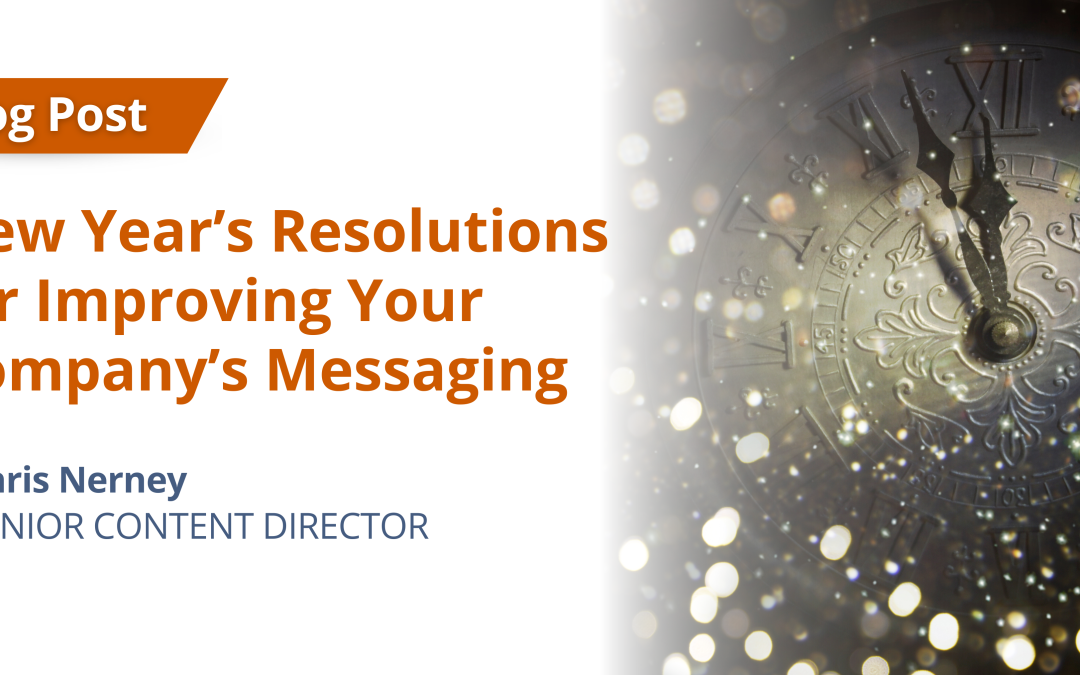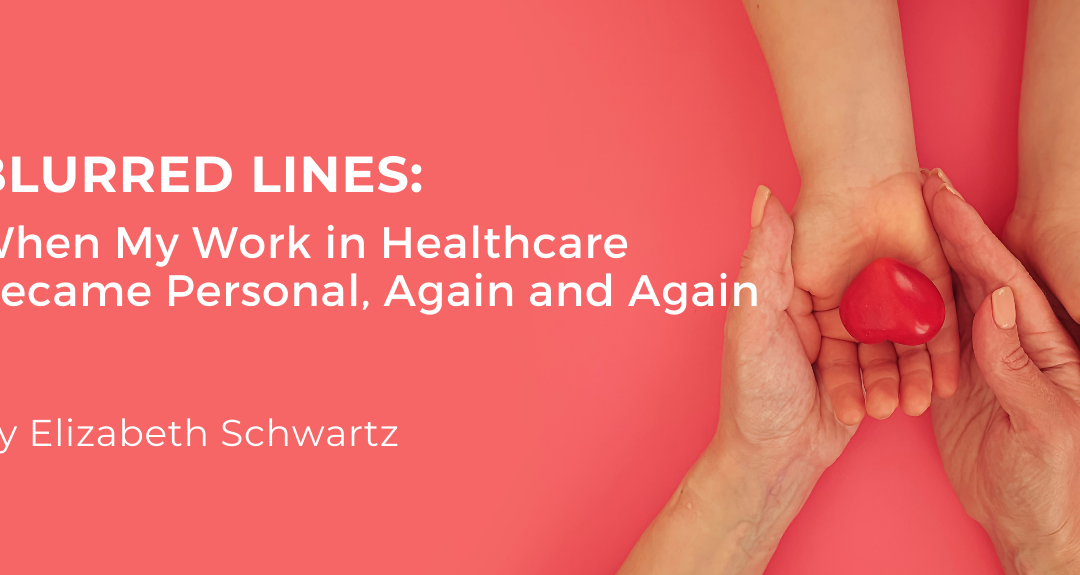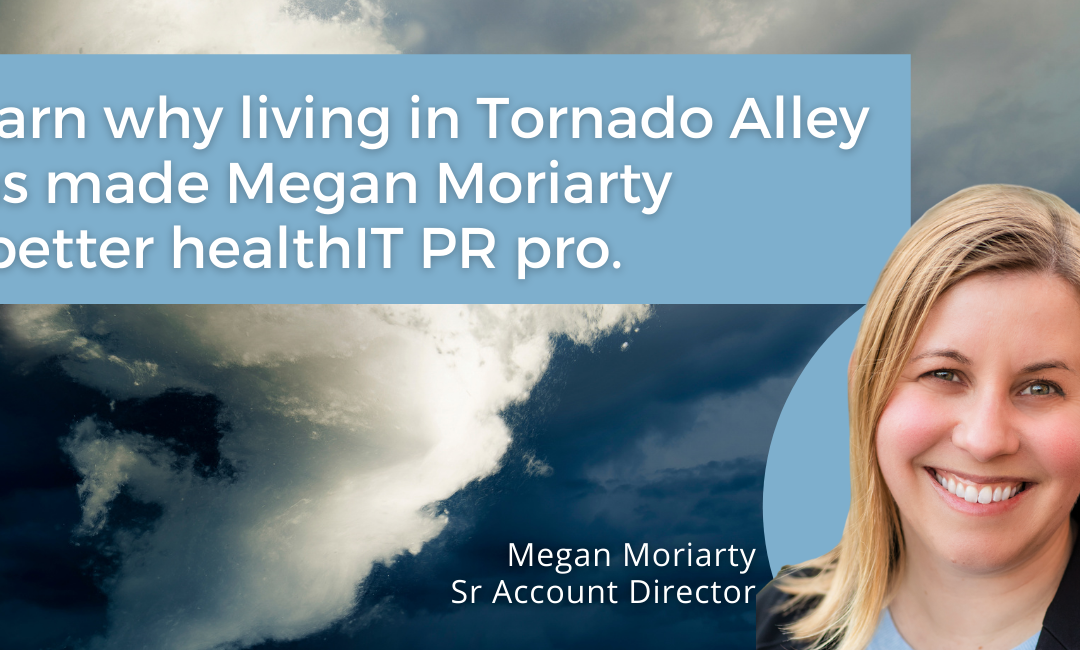
by Chris Nerney | Jan 8, 2025 | Blog
The start of any year is an ideal time for healthcare companies to review and, if necessary, revise their brand messaging. The industry moves fast, and the message that resonated in January may be gathering mold a few quarters later. Or a healthcare company may want to reach a new target audience as its product evolves and market dynamics change.
Here are three possible marketing and public relations resolutions for 2025 that, if embraced, will help healthcare companies raise their profiles and distinguish themselves from the growing crowd.
Lose the meaningless jargon
Stop telling people your company is “transforming healthcare.” It’s a meaningless phrase used by virtually every healthcare startup. I know because I’ve typed variations of the word “transformational” at the behest of countless clients. I haven’t crunched the numbers, but I’d say there are almost as many companies claiming they’re transforming healthcare as there are “visionaries,” “innovators,” and “trailblazers” on LinkedIn.
Likewise, try to eliminate words and phrases such as “value proposition” and “leveraging,” which are best left for business-school debates. As Amendola founder Jodi Amendola wrote in Forbes last summer, such words “are so tired that they have come to mean virtually anything to anyone, and in turn, they have lost all effectiveness in conveying a unique, memorable marketing and communications message.”
If you’re not unique, you don’t stand out. And if you don’t stand out, you’re essentially invisible. Not exactly the “value proposition” you want from your marketing and PR initiatives, is it? Don’t give potential customers a reason to tune you out.
I also think we’re at the point where healthcare companies need to evolve their messaging beyond terms such as “patient journey” and “social determinants of health,” both of which feel dry and disconnected from real people. Unfortunately, I have no better suggestions. Perhaps an innovative, trailblazing visionary can step forward.
Establish a multimedia presence
When social media took off, some healthcare companies became aggressive early adopters while others held back, not sure whether LinkedIn, Twitter, Instagram, and other social platforms were worth their time. If they had to do it all over again, I suspect the laggards would have moved faster to expand their messaging through these channels.
Don’t make the same mistake with multimedia. Audio and video are powerful mediums not only for communicating information, but for connecting with people. For as powerful as the printed word can be, nothing compares to listening to a person talking or watching them speak.
Printed words can’t communicate vocal inflections, eye contact, or a sincere smile the way multimedia can. While these things may not have anything to do with your product’s capabilities or a customer’s specific problems, they can convey a level of trustworthiness and credibility that the printed word can’t match.
A lot of healthcare companies are taking advantage of audio and video podcasts to deliver their message. It would be smart to use those acquired skills to produce short videos for LinkedIn and other social media platforms that make sense for your company. Including videos in press releases is another way to attract media coverage. None of this requires the construction of a video studio; a smartphone and uncluttered background is enough.
Get customers to tell your story
One of the most common challenges facing healthcare companies is persuading customers to help spread the word about their products and services.
Easier said than done, I know. There often are valid reasons why a customer doesn’t want to be co-opted into your PR strategy: They’re busy, they don’t want to be perceived as endorsing a product, and besides, it’s not their job to promote your “transformational” solution.
Nobody, however, is going to tell your story as effectively as a satisfied, real-world customer whose problems you helped to solve. This type of testimonial will resonate with a prospective customer far more deeply than your company pitch deck. Further, having a customer willing to speak publicly will exponentially increase your company’s chances of getting onto conference stages (and thus in front of your target audience). That alone will separate your company from the pack.
Your best chance of getting a customer to talk about your product is to emphasize the genuine benefits to them and remove obstacles (such as investments of time) that are disincentives to participation. If they are truly impressed with your product and you make the process easy for them, customers will be far more likely to talk about how your company’s product helped them. If companies with similar challenges are listening, this messaging will catch their attention.

by Grace Vinton | May 1, 2024 | Blog
Sometimes you say what everybody is thinking. And when that happens, the reaction can be tangible and immediate.
I was a member of a panel at the recent HIMSS conference and was talking about misinformation. At one point I observed, “Healthcare has a B2B problem, but it’s not business to business; it’s boring to boring.”
All of a sudden everybody started snapping their fingers. I hadn’t seen this reaction before and asked whether people were trying to get my attention. It was confusing! Someone said, “No, you’re on fire.” It seems they agreed with what I said and wanted me to keep going, but didn’t want to interrupt me by clapping. Hence the snapping.
That interesting cultural moment wasn’t about me, but about an awareness clearly shared by most healthcare PR and marketing professionals: Healthcare technology companies and their buyers are mired in boredom. Boring problems. Boring solutions. Boring conversations.
The sad reality is that both healthcare technology companies and their customers – providers, payers, and third parties – are afraid to express a strong opinion or point of view for fear of losing business opportunities.
We’re all sick of boring. Still, I get it: Clients don’t want to confuse or concern a potential customer by saying something audacious or expressing bold thoughts. Healthcare tech companies want to focus their message on what their product does and the problems it can solve for customers. No point in straying from focused thought leadership.
While I understand the strategic impulse toward boring, companies that want to stand out from their competitors need to get more creative with their messaging without confusing buyers or pigeonholing the company as providing a specific solution to a specific problem. Otherwise they may continue to float anonymously in a sea of boring.
Below are some tips for healthcare marketing and PR pros to help their clients and organizations inject some personality and perspective into their messaging.
Connect on a human level
This is healthcare. By definition, it’s about people; serving people and connecting with people. One of the best ways to connect with people is to tell a compelling story. People love hearing stories and are drawn in by a narrative arc that features a journey with highs and lows, challenges and triumphs, and lessons learned.
Great storytellers are relatable and interesting and thus able to connect with an audience. Their stories create a whole world that provides context, rather than running an audience through a tedious list of specific product features and use cases. To sell your product, tell your story.
Go multimedia
Storytelling is about more than the written word. Audio and video are powerful mediums for healthcare technology companies to tell their stories. Not only do some audience members absorb information more efficiently through multimedia, allowing them to see and hear the people behind a healthcare technology company leverages that human connection we all seek.
Even a great infographic or data visualization provides a multimedia tool that can help you articulate a story and emphasize key points. Audience members have diverse learning styles and digital literacy skills; adding a multimedia element to your message will broaden its reach.
Initiate and be part of a conversation
Rather than just relentlessly pumping out marketing collateral, healthcare technology companies should strive to be thought leaders in their sector. Having a voice in an ongoing conversation establishes credibility and puts a human face on the company. Healthcare is a mission-based career, so advocating for your mission and what you believe in resonates with a like-minded audience. People don’t follow companies; they follow other people with great ideas.
Bylined articles published on respected healthcare websites are a great vehicle for demonstrating sector expertise and thought leadership. When potential buyers think you really “get” their challenges, they’ll remember you and your company.
Social media also provides an excellent platform for conversations and idea exchange. LinkedIn probably is the best for healthcare professionals, though many also actively use X. Healthcare technology leaders also can connect with their community through organizations like HIMSS or CHIME.
Finally, some healthcare technology companies have been successful in using podcasts to tell their stories. Some are even launching their own podcasts to provide another venue for interacting with an audience.
Speak the truth (with humor)
The great comedians find humor in everyday life. They also find humor in the truth. If healthcare technology leaders speak the truth to their audiences and find a way to inject humor into the message, they will stand out from the crowd. Humor that is informed by a deep understanding of the industry and the challenges of a particular sector can be memorable. If your humorous truths support your value proposition, all the better.
Conclusion
Healthcare technology companies that hide in the herd and play it safe get ignored. To rise above the boring noise and get your message across, you need to inject your marketing and PR initiatives with a strong storyline framework that employs passion, humanity, humor, and a distinctive voice. Sincerity sells because it’s real and conveys a compelling message: We’re all in this together.

by Elizabeth Schwartz | Nov 24, 2021 | Blog
When I was a little girl, I always wanted to be a pediatrician. And a writer. I had no idea as an idealistic young lady that there wasn’t really a career that combined the two disciplines.
And when I learned how long I had to go to school to be a pediatrician, I leaned in a little more on the writing.
It wasn’t until I had leaned way into writing and four years of Journalism school that I got my first job at a multi-hospital research health system. I learned quickly that I could combine my three passions—helping people, healthcare and writing. I was not the one performing the lifesaving transplants, but through my writing I got to share the stories of two sisters who shared a lifesaving kidney transplant and encourage others to be organ donors. It was a great fit. I thought of it as writing. I had learned in Journalism school how to write a lead, a body and a close. I never thought of what I did as storytelling.
Then, as if it couldn’t get any better, I got a job as a writer at a pediatric hospital. I met awe-inspiring families struggling through unimaginable heartache but taking me along and allowing me into their lives to tell their story and show how they battled adversity with strength, bravery and grace.
I got to see the loving way nurses and doctors approached children and their families. I got to see the way parents looked bravely at their children and told them it was going to be OK even when they weren’t sure. I was humbled and grateful for each and every family. I remember thinking that I was so glad to be able to tell their stories but could never imagine being in their shoes. I had found my place: healthcare and writing. But then something happened that changed my perspective completely.
The Tide Turned
About two years into my job, I had children. My son and daughter are 18 months apart in age. When my daughter was six months old, she began to have seizures. We spent weeks in the hospital trying to find the root cause—from a brain tumor to epilepsy—what we found was that she had a stroke at birth and had cerebral palsy. When my son was two, he was diagnosed with autism. What had been unimaginable to me about the lives of those parents had become my life. We spent many days and nights with doctors, nurses, therapists—my colleagues—and now my child’s caregiver. I was the one of the parents that I had been writing about.
Why It Matters
My children have been a consistent source of joy and inspiration to me. I know that doesn’t make me unique as a parent, but when they were young, we journeyed through a lot together in ways I never thought I would experience. All the times I wrote those patient stories, I never knew one day it would be me.
I’m happy to report they are both thriving, active teenagers now. What I learned is that in some way for all of us, healthcare is personal. Whether it’s an aging parent, your own health challenges, or a child, when we walk through our healthcare system as a patient or a caregiver of a patient, it changes us.
For me, it changed the way I write. It changed the way I tell the story of the latest innovation in EHRs. It changed the way I appreciate the passion and selfless care that every single position in the healthcare ecosystem puts into what they do.
I think it’s easy as PR and Marketing professionals to get robotic and apathetic in the way that we amplify a brand or write a blog. What we should remember is that at the end of that journey is a real person with a real story. And you never know when that might be you. Write with your heart. Bring your own story in the passion you have for what you do. It will never steer you wrong.

by Megan Moriarty | Jul 21, 2021 | Blog
Most people working in communications are familiar with the idea that storytelling creates the most impactful and memorable messages. Feeling a human connection to a story is what makes it resonate with us, and what makes us care. Working in the healthcare communications field makes it easy to tell great stories because we’ve all had our own healthcare experiences. Healthcare is personal and we can relate to any number of situations because of that.
When pitching/covering/writing about health IT, it’s important to center around the human element. Amendola CEO Jodi Amendola has shared that the best PR is personal, and the human connection is what makes any story relatable. My colleague Margaret Kelly also recently wrote about her perspective on health IT as a patient. Connecting the features of health tech to end users (physicians and other care providers) and to the ultimate benefits to patients makes stories more powerful and demonstrates the value of technology.
In the health IT world, there’s so much innovation and so many new tools, programs and systems that can improve the healthcare system. But the most important stories in health IT are not about the technology but instead about the patients who ultimately benefit from the technology. Patients are the ultimate beneficiary of all the innovation happening in healthcare, from safety, to efficiency, to patient satisfaction and ultimately improved health outcomes.
If, like me, you’ve had a telemedicine appointment this year because of COVID-19, you’ve experienced health tech innovation firsthand. While telehealth was not initially conceived as a method for delivering health care to prevent viral spread during a pandemic, it’s an unexpected use case for an innovation that was originally thought of as a convenience. The rapid adoption of telemedicine during the COVID-19 pandemic has likely changed health care delivery, and telemedicine is likely here to stay in a bigger role moving forward.
I can look at my own career in PR and see real-world examples of how healthcare technology benefitted physicians and patients in unexpected ways. I live in the Kansas, which is right in the heart of “Tornado Alley.” No, I’ve never actually seen a tornado, but the sirens are a familiar part of spring and summer in the Midwest. Tornados are destructive and can be deadly – you may remember the horrific destruction of the EF-5 tornado in Joplin, Missouri in 2011 which killed 161 people and badly damaged the local hospital.
Even though there were reports of X-ray films being blown 70 miles away, patient records were also digitized. When the hospital was closed due to the extensive damage, the community set up temporary facilities to care for patients and the clinicians were able to electronically access medical records for those patients. Prior to the widespread adoption of electronic health records, this would not have been possible.
I was also working in health IT when a devastating tornado ripped through a medical center in Oklahoma in 2013. The roof was torn off and the medical center had to evacuate patients to other locations within the regional health system. Before EHRs, this situation would have left clinicians without access to the health records for the patients in their care. But thanks to the digitization of medical records and a regional health information organization (RHIO) for which my employer remotely hosted the records, patients could be transferred to other nearby facilities and physicians could access patients’ records for treatment.
This second example was actually a cover story in Modern Healthcare that highlighted how technology makes our healthcare system better and benefits communities and patients. It may have been an unintended use case for health information exchanges (HIEs) and remotely hosted records for disaster preparedness, but sometimes unforeseen events help to prove the efficiency and value of certain innovations.
Finding a meaningful way to communicate how innovations benefit people makes health IT messages more memorable. To make your health tech story resonant with audiences, always look for the human connection.

by Philip Anast | Dec 9, 2020 | Blog
While our digital age has ushered in not a few changes with respect to the written word and how we communicate, there is a 100+-year-old book that still has something to offer our sophisticated new world.
The Elements of Style, written by William Strunk Jr. and later updated by E.B White, is a valuable reference tool – still on many writers’ desks, or digitally as an app on smart phones.
Strunk was a 20th Century Cornell University professor; E.B. White, a contributor to The New Yorker magazine and author of the children’s book, Charlotte’s Web.
The guide is just 85 pages in length. But therein lies its beauty, simplicity and clarity.
“Vigorous writing is concise,” Strunk writes. “A sentence should contain no unnecessary words, a paragraph no unnecessary sentences, for the same reason that a drawing should have no unnecessary lines and a machine no unnecessary parts. This requires not that the writer make all his sentences short, or that he avoid all detail and treat his subjects only in outline, but that every word tell.”
Other reminders for PR pros in the business of storytelling:
- Use the active voice
- Write with nouns and verbs
- Do not overwrite
- Do not overstate
- Make sure the reader knows who is speaking
- Be clear
- Do not take shortcuts at the cost of clarity
Besides elementary rules of usage and principles of English composition, White included a section entitled, “An Approach to Style.”
“In the days when I was sitting in [Strunk’s] class, he omitted so many needless words, and omitted them so forcibly and with such eagerness and obvious relish, that he often seemed in the position of having shortchanged himself – a man left with nothing more to say yet with time to fill, a radio prophet who had outdistanced the clock,” White writes.
This is a keen reminder that while an unlimited resource, words should be used with care and as if there are only so many to go around.





